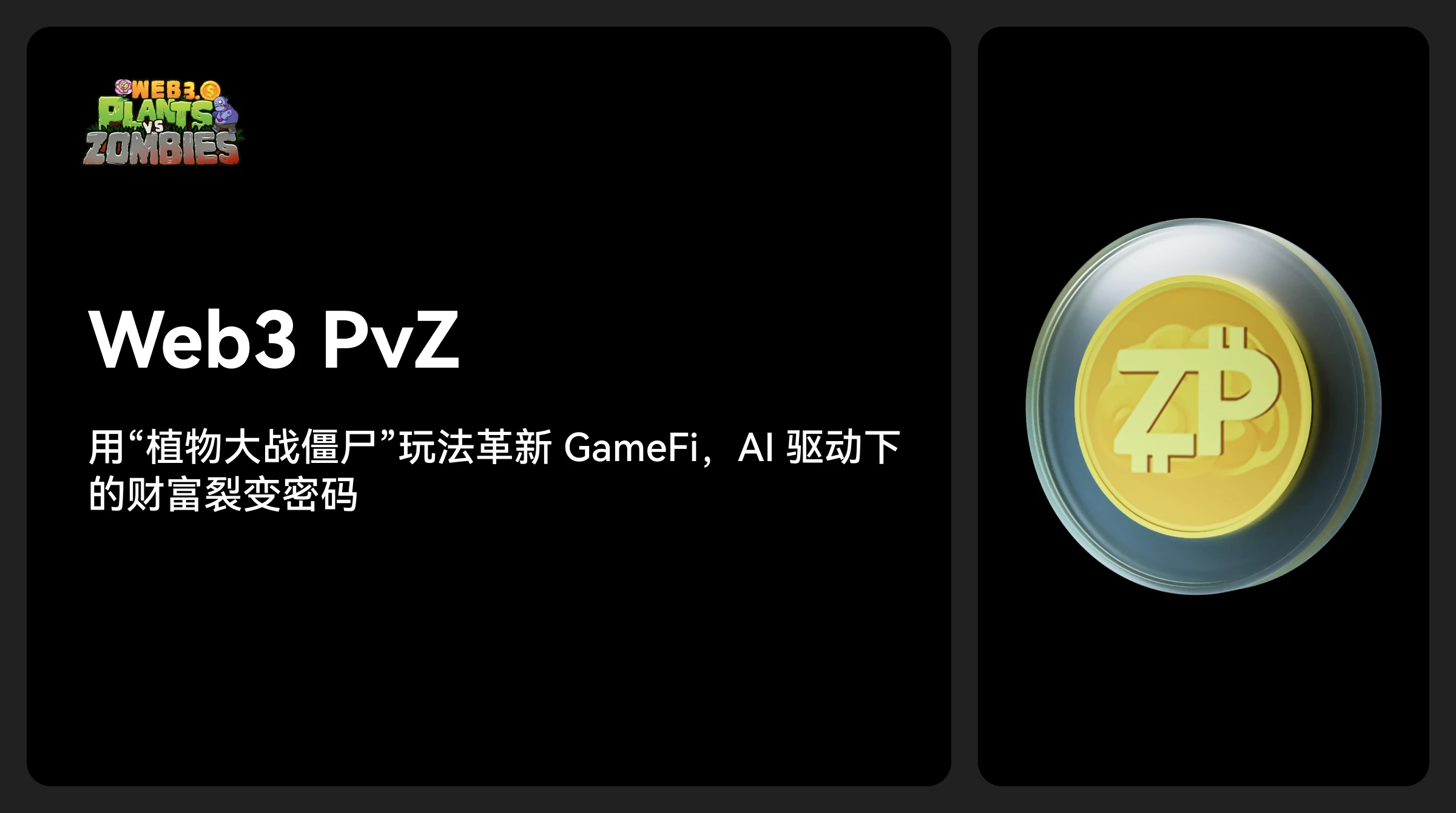
In the vast universe of Web3 games, traditional GameFi projects are like shooting stars, which can shine briefly but cannot last long. Out-of-control token inflation, high user barriers, low player retention rates, and unsustainable economic models are like four invisible shackles that firmly imprison the innovative development of this field, making it difficult for it to move to a broader stage.
However, in this seemingly difficult situation, an emerging project is emerging with its unique innovative model and technical endorsement. Web3 PvZ has attracted widespread attention in the industry. It deeply integrates artificial intelligence technology and blockchain innovation, breaks through the limitations of traditional GameFi, and attracts a large number of users with dynamic economic models and social fission strategies. It has become a rising star in the Web3 game ecosystem.
The Dilemma of Traditional GameFi and the Solution of Web3 PvZ
Traditional GameFi projects are caught in a death spiral: out-of-control token inflation has seriously disrupted the economic balance within the game; high barriers to entry have kept a large number of potential players out; low player retention rates have led to a rapid loss of community vitality; and the lack of sustainability in the economic model has made it difficult for the project to continue and lose the foundation for long-term development.
In this dilemma, Web3 PvZ, inspired by the core fun of the classic game Plants vs. Zombies, combines AI technology and blockchain innovation to propose a new solution. Its core highlight lies in the innovative model of AI-driven sustainable economy + IP-based social fission. This model not only effectively alleviates the economic sustainability problem of traditional GameFi, but also successfully attracts a large number of users by lowering the participation threshold and strengthening social communication.
Official data shows that the number of players of Web3 PvZ exceeded one million just 7 days after its launch, ranking first in NFT sales in the LINE ecosystem and firmly ranking among the top three in terms of activity in the LINE NEXT ecosystem, accelerating the popularization of Web3.
The core innovation of Web3 PvZ: multi-dimensional subversion of traditional blockchain games
Revolutionary AI CFO: Dr. Pump Treasury
Web3 PvZs AI CFO, Dr. Pump Treasury, can be described as the smart butler of the games economic system. It can dynamically adjust the reward distribution mechanism based on real-time on-chain data to make players earnings more reasonable and stable; and accurately formulate airdrop strategies to effectively reward old players while attracting new users; in addition, it can actively hedge against inflation risks and maintain a healthy balance in token value.
This system was developed by the AI team of the University of Sheffield, which continuously optimizes and intelligently adjusts the economic model through advanced algorithms. The operating logic of Dr. Pump Treasury is similar to the matching system in traditional games, but its focus has shifted from player matching to economic balance. The system can monitor key economic data in the game in real time and automatically adjust the total circulation and distribution of tokens accordingly.
Zombie-to-Earn (Z 2 E): The perfect balance of playability and profit
Z2E gameplay is the core game mechanism of Web3 PvZ. It perfectly integrates the classic strategy elements of Plants vs. Zombies with PvE and PvP battles, lowering the threshold of the game while greatly improving player stickiness. During the game, players upgrade zombies through synthesis, participate in PvE and PvP battles, and earn considerable token income. This economic closed-loop design allows players to enjoy the fun of the game while also getting actual economic returns.
Different from the working feeling of players in the traditional Play-to-Earn mode, Z2E emphasizes the entertainment of strategic competition. Players need to use wisdom and skills to formulate different strategies to deal with various challenges. For example, in PvE mode, players need to reasonably match the types and layout of plants according to the characteristics of zombies and level requirements; in PvP mode, players need to compete with opponents for victory.
Cross-platform traffic engine: seamless coverage of Telegram, LINE, Web3 and other platforms
Web3 PvZ is well versed in user growth and makes full use of the click-to-play feature of social platforms to create an efficient cross-platform traffic engine. On social platforms such as Telegram and LINE, players can easily enter the game without complicated operations, and after experiencing it, they are happy to share and recommend it on social networks, thus forming a fission-type dissemination path similar to WeChat Mini Games.
It ranks among the top 3 most active games in the LINE NEXT ecosystem, fully demonstrating the strong growth potential of lightweight entry points. This strategy not only brings considerable user growth to the game, but also effectively promotes the popularization of the Web3 concept among a wider user group. Through seamless multi-platform coverage, Web3 PvZ breaks the device and platform barriers of traditional games, allowing players to play freely on different terminals and enjoy an immersive gaming experience.
Token Economy: ZP’s Value Capture and Sustainable Model
As the core token of Web3 PvZ, ZP has the trinity of governance, circulation and revenue. At the governance level, players can participate in key matters such as game update direction and revenue distribution ratio through DAO voting, realizing true community autonomy; in game circulation, ZP is the core token for NFT transactions, item synthesis, battle betting and other operations, which runs through all aspects of the game; at the same time, ZP is also a carrier of revenue, and players can share game revenue by staking ZP, which is similar to the developer profit-sharing model of Roblox.
In order to achieve the sustainability of the economic model, Web3 PvZ has innovated in token design. Its revenue sources are diverse, covering NFT transaction fees, battle tickets, and advertising placements, and it has expanded its monetization path by leveraging cross-platform traffic advantages. On this basis, the project also introduces an anti-fragile mechanism: through AI, the annualized rate of return (APY) of pledge is dynamically adjusted according to TVL (total locked value), thereby effectively avoiding the death spiral risk common in traditional GameFi.
Specifically, when TVL is high, the AI system will lower the APY for staking to reduce the new supply of tokens and prevent the market from overheating; conversely, when TVL is low, the system will increase the APY to increase the attractiveness of staking and encourage more players to participate. This dynamic adjustment mechanism ensures the long-term stable operation of the token economy and provides players with more confident value guarantees.
All-star team and resources: the perfect fusion of traditional gaming giants and Web3 native
The core team of Web3 PvZ is composed of elites from traditional gaming giants and the Web3 field, with strong cross-border collaborative capabilities. In terms of game development, the former Ubisoft/Nintendo art director has provided solid guarantees for the visual quality of the game with his 20 years of experience in 3A game production; Riot Games senior producer has leveraged his professional advantages in e-sports design to build a highly competitive core gameplay; and Disneys former IP operations director has led the user growth strategy to drive the games rapid expansion.
In terms of blockchain technology and compliance, HashKeys founding team consultants safeguard the projects compliance architecture and liquidity construction; the University of Sheffield AI Laboratory provides underlying algorithm support for the economic model to ensure its intelligence and sustainability.
The project also achieved efficient resource coordination: Telgather Studio, the team of the popular game BANANA, provided channel support, relying on its 18 million player base to bring strong traffic endorsement for the release of Web3 PvZ. At the same time, the project also reached in-depth cooperation with mainstream trading platforms such as Gate.io and OKX to provide strong support for the liquidity construction of the token after it goes online.
Industry significance and future prospects: ecological expansion from games to the metaverse
The paradigm significance of Web3 PvZ
The rise of Web3 PvZ has released an important signal that traditional game giants are accelerating their layout of Web3. Executives from companies such as Disney and Bandai Namco have endorsed it as consultants, demonstrating the traditional game industrys high recognition of this innovative model. The AI + blockchain dynamic economic system built by the project provides a new idea for solving GameFis death spiral dilemma, and its Dr. Pump model has important reference and inspiration value for other DeFi protocols.
As a key node for blockchain games to break through the circle, Web3 PvZ has broken the inherent impression of Axie clone projects with its unique innovative model, opening a new chapter in the era of Web3 game industrialization. Its success not only sets a new industry benchmark for Web3 games, but also provides valuable experience and practical paradigms for traditional game companies to explore the transformation path of Web3.
Ecosystem expansion plan: building a diversified gaming universe
The goal of Web3 PvZ is far more than just creating a blockchain game. It is developing a grand expansion blueprint around the game ecosystem. With community-driven governance as the core concept, the project is gradually handing over the right to adjust game parameters to DAO, truly realizing the players dominance over the direction of the game. At the same time, cross-chain deployment is also progressing steadily, and plans to connect to high-performance public chains such as Solana and Ton to expand a broader technical foundation and user coverage for the long-term development of the game.
In terms of IP expansion, Web3 PvZ has built an imaginative derivative universe. Zombie NFTs are open to secondary creation authorization, encouraging the community to co-create content, and cooperating with traditional game giants to launch physical peripherals, extending the projects influence from the virtual world to real scenes. By building a diversified content ecosystem, Web3 PvZ continues to strengthen its brand value on the one hand, and provides players with more diverse ways to participate and stable income channels on the other.
Web3 Gaming’s “Nintendo Moment”
Just as Nintendo defined console games with Mario, Web3 PvZ is expected to redefine blockchain games with the innovative model of AI + social fission. When AI starts to manage the accounts for games and when zombies can also work and make money, the singularity of Web3 games has arrived. In this era full of opportunities, Web3 PvZ is leading the Web3 game ecosystem towards a new future.










